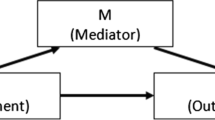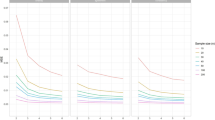Abstract
In randomized clinical trials, the log rank test is often used to test the null hypothesis of the equality of treatment-specific survival distributions. In observational studies, however, the ordinary log rank test is no longer guaranteed to be valid. In such studies we must be cautious about potential confounders; that is, the covariates that affect both the treatment assignment and the survival distribution. In this paper, two cases were considered: the first is when it is believed that all the potential confounders are captured in the primary database, and the second case where a substudy is conducted to capture additional confounding covariates. We generalize the augmented inverse probability weighted complete case estimators for treatment-specific survival distribution proposed in Bai et al. (Biometrics 69:830–839, 2013) and develop the log rank type test in both cases. The consistency and double robustness of the proposed test statistics are shown in simulation studies. These statistics are then applied to the data from the observational study that motivated this research.

Similar content being viewed by others
References
Bai X, Tsiatis AA, O’Brien SM (2013) Doubly-robust estimators of treatment-specific survival distributions in observational studies with stratified sampling. Biometrics 69:830–839
Hubbard AE, van der Laan MJ, Robins JM (1999) Nonparametric locally efficient estimation of the treatment specific survival distributions with right censored data and covariates in observational studies. In: Halloran E, Berry D (eds) Statistical models in epidemiology: the environment and clinical trials. Springer, New York, pp 134–178
Rubin DB (1978) Bayesian inference for causal effects: the role of randomization. Ann Stat 6:34–58
Tsiatis AA (2006) Semiparametric theory and missing data. Springer, New York
Weintraub WS, Grau-Sepulveda MV, Weiss JM, O’Brien SM, Peterson ED, Kolm P, Zhang Z, Klein LW, Shaw RE, McKay C, Ritzenthaler LL, Popma JJ, Messenger JC, Shahian DM, Grover FL, Mayer JE, Shewan CM, Garratt KN, Moussa ID, Dangas GD, Edwards FH (2012) Comparative effectiveness of revascularization strategies. N Engl J Med 366:1467–1476
Xie J, Liu C (2005) Adjusted Kaplan-Meier estimator and log-rank test with inverse probability of treatment weighting for survival data. Stat Med 24:3089–3110
Zhang M, Schaubel DE (2012) Contrasting treatment-specific survival using double-robust estimators. Stat Med 31:4255–4268
Acknowledgments
This research was supported by NIH Grant R01 HL118336.
Author information
Authors and Affiliations
Corresponding author
Rights and permissions
About this article
Cite this article
Bai, X., Tsiatis, A.A. A log rank type test in observational survival studies with stratified sampling. Lifetime Data Anal 22, 280–298 (2016). https://doi.org/10.1007/s10985-015-9331-2
Received:
Accepted:
Published:
Issue Date:
DOI: https://doi.org/10.1007/s10985-015-9331-2




